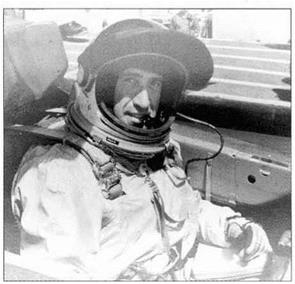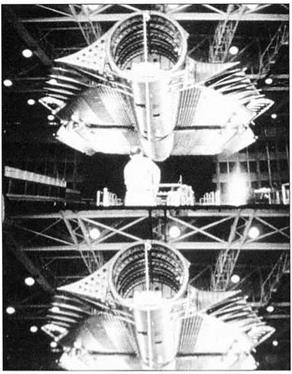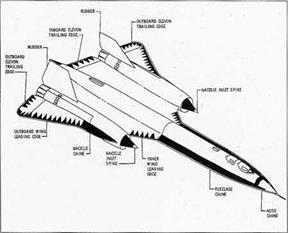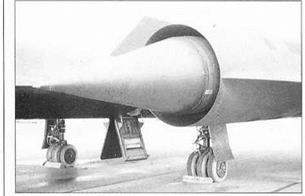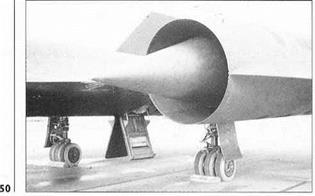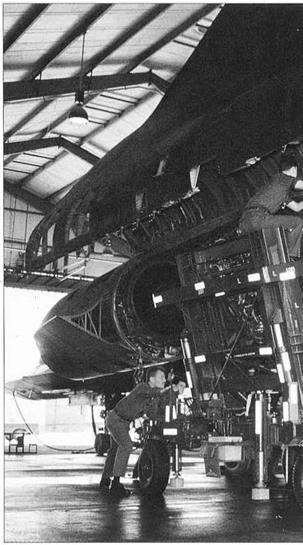The YF-12
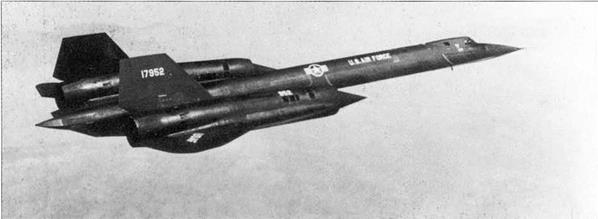 |
During December 1960, a separate project group working independently of the A-12 team, under Rus Daniell, was organised in the Skunk Works. From joint 715, (a point perpendicular to where the inboard wing leading edge meets the fuselage chine), the entire forward fuselage forebody of an A-12 was modified to create a Mach 3.2 interceptor. Originally designated AF-12, its 1,3801b Hughes AN/ASG-18 pulse Doppler radar and 818 lbs GAR-9 missile, had been intended for the North American F-108 Rapier, however following cancellation on 23 September 1959, DoD officials decided that development of this outstanding system should continue on a ‘stand alone’ basis. Therefore Hughes continued R&D
Above Bob Gilliland completes a fly by in ‘950 on its maiden flight over runway 25 at Palmdale. He is being chased by Jim Eastham in F-104 60790. (Lockheed Martin)
Below Lockheed test pilot Bill Weaver survived a Mach 3.1 break-up accident at an altitude of 81,000ft, in SR-7IA, 6417952, on 25 January l966.Tragically, his flight test engineer, Jim Zwayer was killed. (Lockheed Martin)
Below right SR-7IA 64-17953 crashed on 18 December 1969 after an inflight explosion. Lt Col Joe Rogers and RSO Lt Col Garry Heidlebaugh ejected safely. (Lockheed Martin)
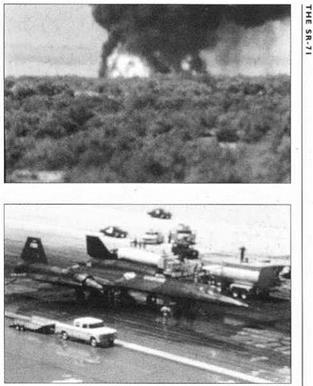 Below, right and below right Lt Col Bill Skliar (pictured) and his RSO, Maj Noel Warner, had a lucky escape at Edwards on I I April 1969, when a wheel disintegrated on rotation and set
Below, right and below right Lt Col Bill Skliar (pictured) and his RSO, Maj Noel Warner, had a lucky escape at Edwards on I I April 1969, when a wheel disintegrated on rotation and set
80,0 lbs of JP-7 ablaze. Luckily both men managed to escape uninjured. SR-71 A, 64-17954 however, was written off. (Paul Crickmore Collection)
|
|
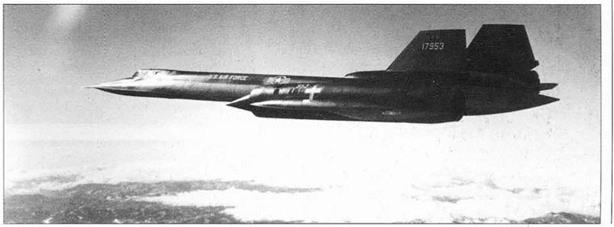 |
work with both systems utilising a specially modified Convair B-58A Hustler.
On 31 May 1960, the Air Force conducted a mock-up review of the AF-12 and were duly impressed. By June, AF-12 wind turned tests revealed directional stability problems resulting from the heavily revised nose profile and cockpit configuration. As a result a large folding fin was mounted under the aft fuselage, as were two shorter fixed fins beneath each nacelle. A bomber version of the A-12, designated the RB-12, also reached the mock-up stage, but this would prove to be still-born, as it repre-, sented too much of a threat to the highly political North American XB-70A Valkyrie. On 7 August 1963, several weeks after being moved to Area 51, Jim Eastham climbed aboard the interceptor prototype and took aircraft 60-6934
(the seventh A-12), for its first flight; a flight he would later modestly describe as a ‘typical production test flight’.
On 24 May 1963, the program received a temporary set back when Agency pilot Ken Collins was forced to eject from A-12 60-6926, during a subsonic test flight. The crash occurred 14 miles south of Wendover, Utah; a press cover story referred to the aircraft as being a Republic F – 105 Thunderchief, thus preserving security. An accident investigation established the cause of the incident to be a pilot-static system failure due to icing.
As 1963 drew to a close, nine A-12s at Groom Lake had notched up a total of 573 flights totalling 765 hours. A year later, eleven A-12s had logged over 1,214 flights amounting to 1,669 hours – only 6 hours 23 minutes however was at Mach 3 and only 33 minutes at design
![]() speed, Mach 3.2. As Oxcart grew in size and cost, concern was expressed within both the Agency and Air Force as to how much longer the program could be kept a secret. It was also noted that technological data accumulated during the project would be of immense value in conjunction with ‘white world’ feasibility studies into supersonic passenger transport. In November 1963, President Johnson was briefed on the programme, after which he directed that a formal announcement be prepared for release early in the new year. Kelly Johnson noted in his diary “Plans going forward for surfacing of the AF-12 program. I worked on the draft to be used by President Johnson and proposed the terminology ‘А-1Г as it was the non-anti-radar version.” On Saturday 29 February 1964, a few’ hours prior to the President announcing the existence of part of the programme, two AF-12s, 60-6934 and 60-6935 were flown from Area 51 to Edwards AFB, by Lou Schalk and Bob Gilliland, thereby diverting attention away from Area 51 and the ‘black w’orld’ A-12 programme. At Edwards a ‘buzz’ had gone out to a few senior staff that something special might be happening on the first morning of their weekend off. In consequence, a few1 dozen people witnessed the arrival of the extremely sleek interceptor, the like of which no one outside the programme had seen – except for a few desert dwellers and the occasional incredulous sighting by airline crews. Lou Schalk recalls taxying to their assigned hangar as eyes bulged and heads nodded in utter disbelief. Unfortunately, the arrival lost a touch of elegance w hen, to aid push-back into the hangar, they turned the aircraft through 180 degrees. Lou recalls “ This turnaround sent hot engine exhaust gases flooding into the hangar which caused the overhead fire extinguishers valves to open. These valves were big – like the flood valves on hangar decks of aircraft carriers – and the desert hadn’t seen so much water since Noah’s embarkation!”
speed, Mach 3.2. As Oxcart grew in size and cost, concern was expressed within both the Agency and Air Force as to how much longer the program could be kept a secret. It was also noted that technological data accumulated during the project would be of immense value in conjunction with ‘white world’ feasibility studies into supersonic passenger transport. In November 1963, President Johnson was briefed on the programme, after which he directed that a formal announcement be prepared for release early in the new year. Kelly Johnson noted in his diary “Plans going forward for surfacing of the AF-12 program. I worked on the draft to be used by President Johnson and proposed the terminology ‘А-1Г as it was the non-anti-radar version.” On Saturday 29 February 1964, a few’ hours prior to the President announcing the existence of part of the programme, two AF-12s, 60-6934 and 60-6935 were flown from Area 51 to Edwards AFB, by Lou Schalk and Bob Gilliland, thereby diverting attention away from Area 51 and the ‘black w’orld’ A-12 programme. At Edwards a ‘buzz’ had gone out to a few senior staff that something special might be happening on the first morning of their weekend off. In consequence, a few1 dozen people witnessed the arrival of the extremely sleek interceptor, the like of which no one outside the programme had seen – except for a few desert dwellers and the occasional incredulous sighting by airline crews. Lou Schalk recalls taxying to their assigned hangar as eyes bulged and heads nodded in utter disbelief. Unfortunately, the arrival lost a touch of elegance w hen, to aid push-back into the hangar, they turned the aircraft through 180 degrees. Lou recalls “ This turnaround sent hot engine exhaust gases flooding into the hangar which caused the overhead fire extinguishers valves to open. These valves were big – like the flood valves on hangar decks of aircraft carriers – and the desert hadn’t seen so much water since Noah’s embarkation!”
|
|
Above The rear fuselage section, aft of joint 715, is moved on to the next jig. (Lockheed Martin)
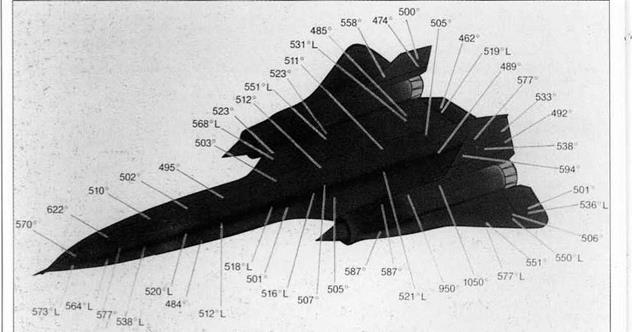 |
Below Temperatures excountered whilst at cruise speed and altitude dictated the use of titanium. (Lockheed Martin)
Now an Air Force program, the aircraft’s designation was changed to YF-12A to suit their system. The third YF-12A, 60-6936, soon joined the other two at Edwards and Jim Eastham continued the envelope expansion programme. On 16 April 1964, the first airborne AIM-47 missile separation test was conducted. Unfortunately, as onboard cameras showed, the weapon’s nose-down pitch was inadequate: had the rocket motor ignition also been fired, the missile would probably have ended up in the front cockpit! Back at ‘the Ranch’, on 9 July 1964, Bill Park experienced a complete lock-up of his flight controls in aircraft 60-6939 as he descended for landing following a high Mach flight. Despite trying to save the brand-new aircraft from rolling under while turning on to final approach, he couldn’t stop the bank angle from increasing and was forced to eject. Punching out at 200kts in a 34 degree bank, no more than 200 ft above the ground, Park was extremely lucky to survive unscathed.
A milestone in the programme was reached on 27 January 1965, when an A-12 flew’ a 2,580 mile sortie in one hour forty minutes, w’ith three-quarters of the flight time spent at Mach 3.1. On 18 March, YF-12A ‘935 successfully engaged a Qj2C target drone at 40,000ft, whilst the interceptor flew at Mach 2.2 and 65,000ft.
Then on 1 May 1965 (five years to the day that Gary Powers was shot down in his U-2), YF-12A 60-6936 siczed back from the Soviet Union six world speed and altitude records. Fourteen days later, the Skunk Works
|
|
Above To reduce the SR-71’s radar signature, radar absorbent material (RAM) is used. (Lockheed Martin)
![]()
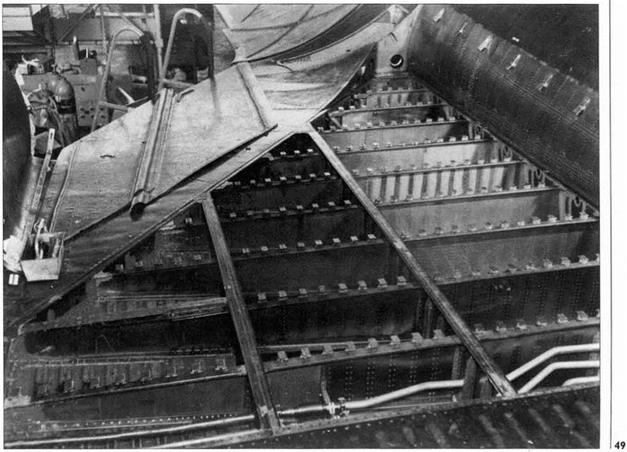 |
Below An ingenious stand-off clip, developed by Skunk Works engineers, overcame the problem of attaching thin titanium sheets to bulkier structural components, without the former tearing due to expansion rates differentials. (Lockheed Martin)
![]()
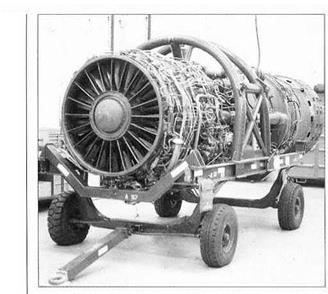 Above The SR-71 is powered by two Pratt & Whitney JT11D-20 engines, designated J58 by the military. (Paul Crickmore)
Above The SR-71 is powered by two Pratt & Whitney JT11D-20 engines, designated J58 by the military. (Paul Crickmore)
below and bottom To regulate the amount of air required by the propulsion system throughout its vast operating envelope, the centrebody spike translates back and forth. (Paul Crikcmore)
|
|
|
|
received a contract for S500,000 for the production version of the interceptor, designated F-12B. However, production go-ahead was not given with the engineering contract. Nonetheless, considerable optimism was generated. A further half-million dollars was granted on 10 November to keep basic F-12B design work alive. Similarly, Hughes received S4.S million to continue development of the AN/ASG-18 radar and fire control system.
On 29 March 1966, Kelly had a long meeting with Col Ben Beilis, System Project Officer (SPO) at Hughes Aircraft Company and various members of the F-12 test force, during which he was asked to take on the task of integrating the weapons systems; this he agreed to do and fire control tests were continued. However, Secretary of Defence McNamara opposed production of the aircraft.
As a result, on three occasions over the intervening two years, he denied the Air Force access to S90 million worth of funds which had been appropriated by Congress to begin F-12B production. Following a Senate Armed Sendees Committee hearing into the future of continental air defence, it was decided, in the light of intelligence
|
|
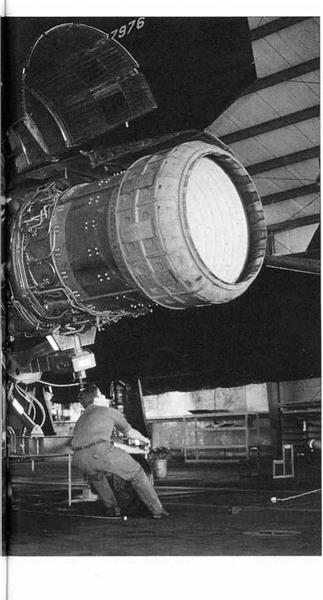 available at the time, to downgrade Aerospace Defence Command, which rendered the F-12B unnecessary. On 5 January 1968, official notification was received from the Air Force to ‘close down the F-12B’; the YF-12A programme was formally ended on I February 1968.
available at the time, to downgrade Aerospace Defence Command, which rendered the F-12B unnecessary. On 5 January 1968, official notification was received from the Air Force to ‘close down the F-12B’; the YF-12A programme was formally ended on I February 1968.
It would be the Blackworld, A-12 Oxcart program that validated the concept of sustained high Mach flight, but there was still a way to go…











